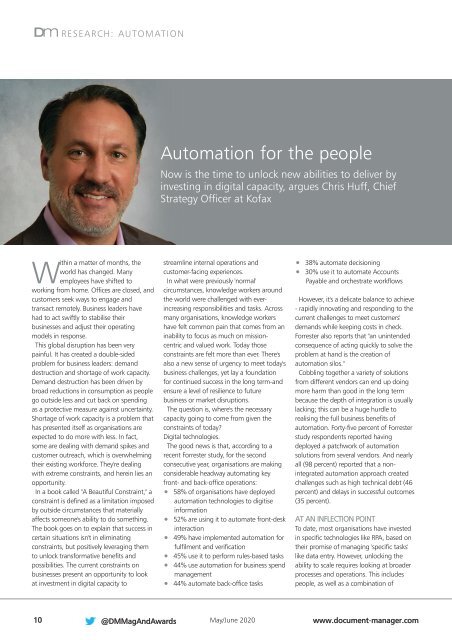DM May-Jun 2020
You also want an ePaper? Increase the reach of your titles
YUMPU automatically turns print PDFs into web optimized ePapers that Google loves.
Dm RESEARCH: AUTOMATION<br />
Automation for the people<br />
Now is the time to unlock new abilities to deliver by<br />
investing in digital capacity, argues Chris Huff, Chief<br />
Strategy Officer at Kofax<br />
Within a matter of months, the<br />
world has changed. Many<br />
employees have shifted to<br />
working from home. Offices are closed, and<br />
customers seek ways to engage and<br />
transact remotely. Business leaders have<br />
had to act swiftly to stabilise their<br />
businesses and adjust their operating<br />
models in response.<br />
This global disruption has been very<br />
painful. It has created a double-sided<br />
problem for business leaders: demand<br />
destruction and shortage of work capacity.<br />
Demand destruction has been driven by<br />
broad reductions in consumption as people<br />
go outside less and cut back on spending<br />
as a protective measure against uncertainty.<br />
Shortage of work capacity is a problem that<br />
has presented itself as organisations are<br />
expected to do more with less. In fact,<br />
some are dealing with demand spikes and<br />
customer outreach, which is overwhelming<br />
their existing workforce. They're dealing<br />
with extreme constraints, and herein lies an<br />
opportunity.<br />
In a book called "A Beautiful Constraint," a<br />
constraint is defined as a limitation imposed<br />
by outside circumstances that materially<br />
affects someone's ability to do something.<br />
The book goes on to explain that success in<br />
certain situations isn't in eliminating<br />
constraints, but positively leveraging them<br />
to unlock transformative benefits and<br />
possibilities. The current constraints on<br />
businesses present an opportunity to look<br />
at investment in digital capacity to<br />
streamline internal operations and<br />
customer-facing experiences.<br />
In what were previously 'normal'<br />
circumstances, knowledge workers around<br />
the world were challenged with everincreasing<br />
responsibilities and tasks. Across<br />
many organisations, knowledge workers<br />
have felt common pain that comes from an<br />
inability to focus as much on missioncentric<br />
and valued work. Today those<br />
constraints are felt more than ever. There's<br />
also a new sense of urgency to meet today's<br />
business challenges, yet lay a foundation<br />
for continued success in the long term-and<br />
ensure a level of resilience to future<br />
business or market disruptions.<br />
The question is, where's the necessary<br />
capacity going to come from given the<br />
constraints of today?<br />
Digital technologies.<br />
The good news is that, according to a<br />
recent Forrester study, for the second<br />
consecutive year, organisations are making<br />
considerable headway automating key<br />
front- and back-office operations:<br />
58% of organisations have deployed<br />
automation technologies to digitise<br />
information<br />
52% are using it to automate front-desk<br />
interaction<br />
49% have implemented automation for<br />
fulfilment and verification<br />
45% use it to perform rules-based tasks<br />
44% use automation for business spend<br />
management<br />
44% automate back-office tasks<br />
38% automate decisioning<br />
30% use it to automate Accounts<br />
Payable and orchestrate workflows<br />
However, it's a delicate balance to achieve<br />
- rapidly innovating and responding to the<br />
current challenges to meet customers'<br />
demands while keeping costs in check.<br />
Forrester also reports that "an unintended<br />
consequence of acting quickly to solve the<br />
problem at hand is the creation of<br />
automation silos."<br />
Cobbling together a variety of solutions<br />
from different vendors can end up doing<br />
more harm than good in the long term<br />
because the depth of integration is usually<br />
lacking; this can be a huge hurdle to<br />
realising the full business benefits of<br />
automation. Forty-five percent of Forrester<br />
study respondents reported having<br />
deployed a patchwork of automation<br />
solutions from several vendors. And nearly<br />
all (98 percent) reported that a nonintegrated<br />
automation approach created<br />
challenges such as high technical debt (46<br />
percent) and delays in successful outcomes<br />
(35 percent).<br />
AT AN INFLECTION POINT<br />
To date, most organisations have invested<br />
in specific technologies like RPA, based on<br />
their promise of managing 'specific tasks'<br />
like data entry. However, unlocking the<br />
ability to scale requires looking at broader<br />
processes and operations. This includes<br />
people, as well as a combination of<br />
10<br />
@<strong>DM</strong>MagAndAwards<br />
<strong>May</strong>/<strong>Jun</strong>e <strong>2020</strong><br />
www.document-manager.com

















